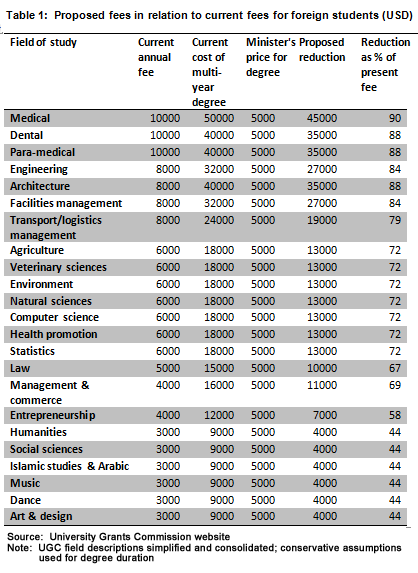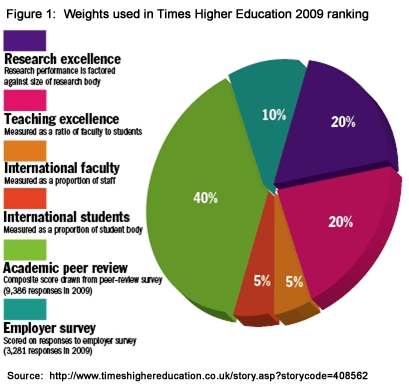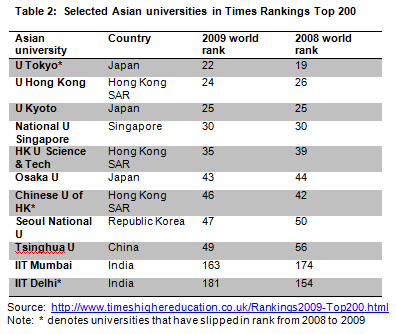Aug 30, 2010 (LBO) - The Minister of Higher Education has been quoted in the media as planning to reduce the fees charged from foreign students wishing to enroll in Sri Lanka universities: It will be a good way to generate more foreign income. We hope to offer a degree for US $ 5,000 to foreign students.
It was reported in astate-run
newspaper
Degree for sale
He does not explicitly state that it is a reduction. But USD 5000 is a significant reduction from the
current fees stated in the
University Grants Commission website.

These are serious reductions. Somewhere on the scale of duty reductions for cars with regard to the cheap degrees, but extraordinary with respect to the expensive degrees.
But let us give the benefit of the doubt to the Minister. After all, his trade mark is impulsive speaking. On the occasion of the Minister assuming office, Ven Bellanwila Wimalaratana thero explicitly advised him to speak with care. And he was reported by the government newspaper which does not put a premium on accuracy.
So let us assume he meant USD 5000 for a year, not for the whole degree. Even then, there still is a reduction for everything above law in the above table.
Oh, and he is also planning to give 200 scholarships to students from China, the Middle East and Africa. Let us assume they are partial scholarships.
There is a pattern here. He understands that his goal of having 10,000 foreign students in Sri Lankan universities cannot be achieved on the basis of quality; he understands he’ll have to market on price, not quality.
Quality
Why would foreign students enroll in Sri Lankan universities? One would assume that students (and parents) wishing to obtain a quality education, would look at rankings.
The Times Higher Education magazine produces world university rankings every year (
http://www.timeshighereducation.co.uk/WUR.html). The Times Higher Education-QS World University Rankings have been produced since 2004 using the methodology represented by the weights given in Figure 1 below.

The competitor to the Times ranking is the Academic Ranking of World Universities produced annually by the Shanghai Jiao Tong University (
http://www.arwu.org/ARWU2009.jsp). While the Times ranking has its biases, it is recognized that the Jiao Tong ranking has an even stronger bias toward research universities that produce Nobel laureates (
http://www.arwu.org/ARWUMethodology2009.jsp).
Some time back, the now defunct Asiaweek published an Asian universities ranking (
http://cgi.cnn.com/ASIANOW/asiaweek/features/universities2000/schools/multi.overall.html). The 1999 rankings covered 77 universities. University of Colombo was the 77th. But obviously, we cannot make decisions based on 1999 rankings.
So this is the best we got.
Where are the Sri Lankan universities?

Table 2 shows the rankings for all Asian universities in the Top 50. They are all from East Asia: three from Japan; three from Hong Kong; and one each from Singapore, South Korea and China. There are no South Asian universities in the Top 50.
The Table shows all South Asian universities in the Top 200. There are only two. Both are IITs from India, occupying 163rd and 181st places.
And Sri Lanka? Nowhere.
No wonder the Minister wants to give USD 5000 degrees. Perhaps he knows that that’s all they are worth.
First step
Simply increasing the salaries of university teachers to a maximum of LKR 200,000 per month (with a minimum of LKR 72,000 per month), as the Minister is supposed to have stated in Parliament (
http://www.lankanewspapers.com/news/2010/7/58689.html), is not the solution. How will this address the problems that he himself describes below?
"In some of these universities nearly all students have got first and second class honours and only one has got a normal pass," Dissanayake quipped.
"In a normal situation this can't happen and only a few will pass with a first class, so there is something wrong with the syllabi and the education system." (
http://www.lankabusinessonline.com/education-promises/)
What is required is a laser-like focus on quality. For that it is necessary to start with faculty. The first step is to accept that we have universities in name only; that the people responsible for this tragedy are the faculty who teach, who administer the "universities" and who have been responsible through wrong hiring and promotion practices of degrading the quality of their establishments.
There has, no doubt, been political interference. But as the behavior of most vice chancellors and university teachers during the presidential election demonstrated, politicians were not the only ones at fault. And no one compelled them to make bad hires and give promotions irrespective of performance, and in some cases even in the face of documented plagiarism and other misdemeanors.
China had universities in name only, as a result of the depredations of Red Guards during the Cultural Revolution. It now has world-class universities led by Tsinghua University (49th) and Beijing University (52nd). Germany cleaned up the politics-ridden universities of the former East Germany.
Hong Kong has a total of eight government-funded tertiary institutions. Of these, five are in the THE-QS top 200 in 2009. They include three in the top 50: the University of Hong Kong (up two places to 24th); Hong Kong University of Science and Technology (up four to 35th); and the Chinese University of Hong Kong (down four to 46th). Al this happened since the 1990s. Reforms can be done; results can be shown; students can be attracted for quality, not for USD 5000 degrees. Not instantly, but five to ten years into hard, deep reforms.
So if the Minister wants to attract foreign students here, or if he simply wants to give our students a high-quality education, the place to start is honest self-assessment. He has to admit that we have universities in name only. From there we can commence the twelve steps to recovery.
Rohan Samarajiva heads LirneAsia, a regional think tank. He was also a former telecoms regulator in Sri Lanka. To read previous columns go to LBOs main navigation panel and click on the 'Choices' category.
Clarification: The Times Higher Education magazine has responded to this column saying it is no longer associated with the Times newspaper group and from this this year (Autumn 2010) it will publish a world ranking of universities based on a more detailed methodology with data provided by Thomson Reuters.
More details could be found at the following link.
http://www.timeshighereducation.co.uk/story.asp?sectioncode=26&storycode=408908&navcode=105
The magazine said the latest news on the rankings could be found here.
http://www.timeshighereducation.co.uk/ or follow us on twitter:
http://twitter.com/THEWorldUniRank.  These are serious reductions. Somewhere on the scale of duty reductions for cars with regard to the cheap degrees, but extraordinary with respect to the expensive degrees.
But let us give the benefit of the doubt to the Minister. After all, his trade mark is impulsive speaking. On the occasion of the Minister assuming office, Ven Bellanwila Wimalaratana thero explicitly advised him to speak with care. And he was reported by the government newspaper which does not put a premium on accuracy.
So let us assume he meant USD 5000 for a year, not for the whole degree. Even then, there still is a reduction for everything above law in the above table.
Oh, and he is also planning to give 200 scholarships to students from China, the Middle East and Africa. Let us assume they are partial scholarships.
There is a pattern here. He understands that his goal of having 10,000 foreign students in Sri Lankan universities cannot be achieved on the basis of quality; he understands he’ll have to market on price, not quality.
Quality
Why would foreign students enroll in Sri Lankan universities? One would assume that students (and parents) wishing to obtain a quality education, would look at rankings.
The Times Higher Education magazine produces world university rankings every year (http://www.timeshighereducation.co.uk/WUR.html). The Times Higher Education-QS World University Rankings have been produced since 2004 using the methodology represented by the weights given in Figure 1 below.
These are serious reductions. Somewhere on the scale of duty reductions for cars with regard to the cheap degrees, but extraordinary with respect to the expensive degrees.
But let us give the benefit of the doubt to the Minister. After all, his trade mark is impulsive speaking. On the occasion of the Minister assuming office, Ven Bellanwila Wimalaratana thero explicitly advised him to speak with care. And he was reported by the government newspaper which does not put a premium on accuracy.
So let us assume he meant USD 5000 for a year, not for the whole degree. Even then, there still is a reduction for everything above law in the above table.
Oh, and he is also planning to give 200 scholarships to students from China, the Middle East and Africa. Let us assume they are partial scholarships.
There is a pattern here. He understands that his goal of having 10,000 foreign students in Sri Lankan universities cannot be achieved on the basis of quality; he understands he’ll have to market on price, not quality.
Quality
Why would foreign students enroll in Sri Lankan universities? One would assume that students (and parents) wishing to obtain a quality education, would look at rankings.
The Times Higher Education magazine produces world university rankings every year (http://www.timeshighereducation.co.uk/WUR.html). The Times Higher Education-QS World University Rankings have been produced since 2004 using the methodology represented by the weights given in Figure 1 below.
 The competitor to the Times ranking is the Academic Ranking of World Universities produced annually by the Shanghai Jiao Tong University (http://www.arwu.org/ARWU2009.jsp). While the Times ranking has its biases, it is recognized that the Jiao Tong ranking has an even stronger bias toward research universities that produce Nobel laureates (http://www.arwu.org/ARWUMethodology2009.jsp).
Some time back, the now defunct Asiaweek published an Asian universities ranking (http://cgi.cnn.com/ASIANOW/asiaweek/features/universities2000/schools/multi.overall.html). The 1999 rankings covered 77 universities. University of Colombo was the 77th. But obviously, we cannot make decisions based on 1999 rankings.
So this is the best we got.
Where are the Sri Lankan universities?
The competitor to the Times ranking is the Academic Ranking of World Universities produced annually by the Shanghai Jiao Tong University (http://www.arwu.org/ARWU2009.jsp). While the Times ranking has its biases, it is recognized that the Jiao Tong ranking has an even stronger bias toward research universities that produce Nobel laureates (http://www.arwu.org/ARWUMethodology2009.jsp).
Some time back, the now defunct Asiaweek published an Asian universities ranking (http://cgi.cnn.com/ASIANOW/asiaweek/features/universities2000/schools/multi.overall.html). The 1999 rankings covered 77 universities. University of Colombo was the 77th. But obviously, we cannot make decisions based on 1999 rankings.
So this is the best we got.
Where are the Sri Lankan universities?
 Table 2 shows the rankings for all Asian universities in the Top 50. They are all from East Asia: three from Japan; three from Hong Kong; and one each from Singapore, South Korea and China. There are no South Asian universities in the Top 50.
The Table shows all South Asian universities in the Top 200. There are only two. Both are IITs from India, occupying 163rd and 181st places.
And Sri Lanka? Nowhere.
No wonder the Minister wants to give USD 5000 degrees. Perhaps he knows that that’s all they are worth.
First step
Simply increasing the salaries of university teachers to a maximum of LKR 200,000 per month (with a minimum of LKR 72,000 per month), as the Minister is supposed to have stated in Parliament (http://www.lankanewspapers.com/news/2010/7/58689.html), is not the solution. How will this address the problems that he himself describes below?
"In some of these universities nearly all students have got first and second class honours and only one has got a normal pass," Dissanayake quipped.
"In a normal situation this can't happen and only a few will pass with a first class, so there is something wrong with the syllabi and the education system." (http://www.lankabusinessonline.com/education-promises/)
What is required is a laser-like focus on quality. For that it is necessary to start with faculty. The first step is to accept that we have universities in name only; that the people responsible for this tragedy are the faculty who teach, who administer the "universities" and who have been responsible through wrong hiring and promotion practices of degrading the quality of their establishments.
There has, no doubt, been political interference. But as the behavior of most vice chancellors and university teachers during the presidential election demonstrated, politicians were not the only ones at fault. And no one compelled them to make bad hires and give promotions irrespective of performance, and in some cases even in the face of documented plagiarism and other misdemeanors.
China had universities in name only, as a result of the depredations of Red Guards during the Cultural Revolution. It now has world-class universities led by Tsinghua University (49th) and Beijing University (52nd). Germany cleaned up the politics-ridden universities of the former East Germany.
Hong Kong has a total of eight government-funded tertiary institutions. Of these, five are in the THE-QS top 200 in 2009. They include three in the top 50: the University of Hong Kong (up two places to 24th); Hong Kong University of Science and Technology (up four to 35th); and the Chinese University of Hong Kong (down four to 46th). Al this happened since the 1990s. Reforms can be done; results can be shown; students can be attracted for quality, not for USD 5000 degrees. Not instantly, but five to ten years into hard, deep reforms.
So if the Minister wants to attract foreign students here, or if he simply wants to give our students a high-quality education, the place to start is honest self-assessment. He has to admit that we have universities in name only. From there we can commence the twelve steps to recovery.
Rohan Samarajiva heads LirneAsia, a regional think tank. He was also a former telecoms regulator in Sri Lanka. To read previous columns go to LBOs main navigation panel and click on the 'Choices' category.
Clarification: The Times Higher Education magazine has responded to this column saying it is no longer associated with the Times newspaper group and from this this year (Autumn 2010) it will publish a world ranking of universities based on a more detailed methodology with data provided by Thomson Reuters.
More details could be found at the following link.
http://www.timeshighereducation.co.uk/story.asp?sectioncode=26&storycode=408908&navcode=105
The magazine said the latest news on the rankings could be found here.
http://www.timeshighereducation.co.uk/ or follow us on twitter: http://twitter.com/THEWorldUniRank.
Table 2 shows the rankings for all Asian universities in the Top 50. They are all from East Asia: three from Japan; three from Hong Kong; and one each from Singapore, South Korea and China. There are no South Asian universities in the Top 50.
The Table shows all South Asian universities in the Top 200. There are only two. Both are IITs from India, occupying 163rd and 181st places.
And Sri Lanka? Nowhere.
No wonder the Minister wants to give USD 5000 degrees. Perhaps he knows that that’s all they are worth.
First step
Simply increasing the salaries of university teachers to a maximum of LKR 200,000 per month (with a minimum of LKR 72,000 per month), as the Minister is supposed to have stated in Parliament (http://www.lankanewspapers.com/news/2010/7/58689.html), is not the solution. How will this address the problems that he himself describes below?
"In some of these universities nearly all students have got first and second class honours and only one has got a normal pass," Dissanayake quipped.
"In a normal situation this can't happen and only a few will pass with a first class, so there is something wrong with the syllabi and the education system." (http://www.lankabusinessonline.com/education-promises/)
What is required is a laser-like focus on quality. For that it is necessary to start with faculty. The first step is to accept that we have universities in name only; that the people responsible for this tragedy are the faculty who teach, who administer the "universities" and who have been responsible through wrong hiring and promotion practices of degrading the quality of their establishments.
There has, no doubt, been political interference. But as the behavior of most vice chancellors and university teachers during the presidential election demonstrated, politicians were not the only ones at fault. And no one compelled them to make bad hires and give promotions irrespective of performance, and in some cases even in the face of documented plagiarism and other misdemeanors.
China had universities in name only, as a result of the depredations of Red Guards during the Cultural Revolution. It now has world-class universities led by Tsinghua University (49th) and Beijing University (52nd). Germany cleaned up the politics-ridden universities of the former East Germany.
Hong Kong has a total of eight government-funded tertiary institutions. Of these, five are in the THE-QS top 200 in 2009. They include three in the top 50: the University of Hong Kong (up two places to 24th); Hong Kong University of Science and Technology (up four to 35th); and the Chinese University of Hong Kong (down four to 46th). Al this happened since the 1990s. Reforms can be done; results can be shown; students can be attracted for quality, not for USD 5000 degrees. Not instantly, but five to ten years into hard, deep reforms.
So if the Minister wants to attract foreign students here, or if he simply wants to give our students a high-quality education, the place to start is honest self-assessment. He has to admit that we have universities in name only. From there we can commence the twelve steps to recovery.
Rohan Samarajiva heads LirneAsia, a regional think tank. He was also a former telecoms regulator in Sri Lanka. To read previous columns go to LBOs main navigation panel and click on the 'Choices' category.
Clarification: The Times Higher Education magazine has responded to this column saying it is no longer associated with the Times newspaper group and from this this year (Autumn 2010) it will publish a world ranking of universities based on a more detailed methodology with data provided by Thomson Reuters.
More details could be found at the following link.
http://www.timeshighereducation.co.uk/story.asp?sectioncode=26&storycode=408908&navcode=105
The magazine said the latest news on the rankings could be found here.
http://www.timeshighereducation.co.uk/ or follow us on twitter: http://twitter.com/THEWorldUniRank. 